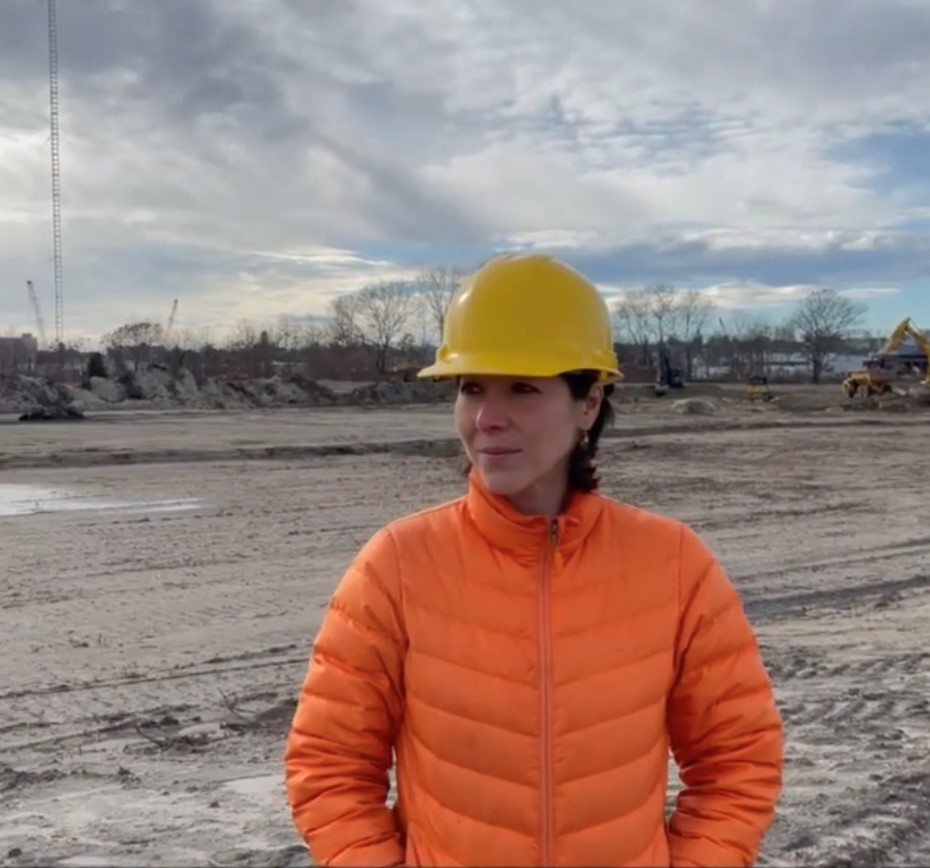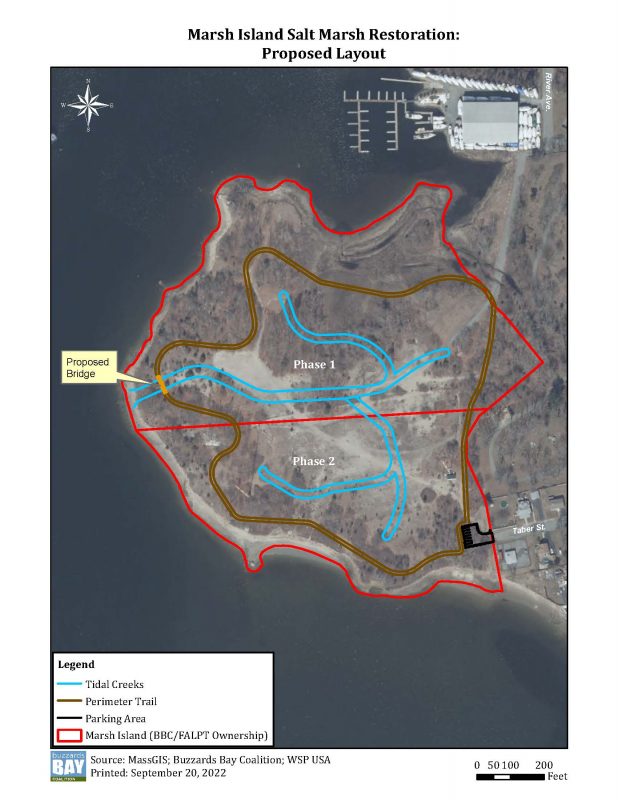All Things Marsh Island with Sara da Silva Quintal
Among the historic buildings and commercial fishing vessels that populate New Bedford Harbor’s shoreline, Marsh Island has stood out as a rare, undeveloped stretch in this maritime hub.
The next time you find yourself driving east over the Route 195 bridge, you’ll likely see construction crews filtering past Breakwater Marinas (formerly Moby Dick Marina) in Fairhaven, as construction has officially begun on the Marsh Island Salt Marsh Restoration Project.
Since 2011, Sara da Silva Quintal, the Restoration Ecologist at the Buzzards Bay Coalition, has been managing the Coalition’s various restoration projects from feasibility phase through permitting, construction, and post-construction monitoring. We spoke with Sara to learn more about how the Marsh Island project came to fruition, and what we can expect to find when construction is complete.

Buzzards Bay Coalition Restoration Ecologist Sara da Silva Quintal.
BBC: Can you give a brief history of Marsh Island, and how it came to be in its current state?
Marsh Island was originally a salt marsh with granite outcrops separated from the mainland by tidal creeks. Historically, Marsh Island was used for recreation and picnicking in the 1800’s. It became a granite quarry through the late 1800’s. From the 1930’s to 1950’s, sediment dredged from the harbor was used to fill the old quarry and the marsh on the island. In 1955, two radio towers were constructed on the filled sandy area on the south side of Marsh Island. This peninsula of land is the largest remaining stretch of undeveloped land along New Bedford’s Inner Harbor. Between 2003 and 2007, the property was purchased for permanent protection with funds from the New Bedford Harbor Trustee Council. It is now owned by Buzzards Bay Coalition and the Fairhaven-Acushnet Land Preservation Trust with plans underway to restore 11 acres of historically-filled salt marsh.
BBC: Why is it important to restore Marsh Island?
The loss of wetlands on Marsh Island is part of a larger story – an estimated 134 acres of wetlands were filled along the Acushnet River with the construction of textile mills beginning in the 1880’s. This is an opportunity to restore a significant amount of salt marsh habitat that had been destroyed in the inner harbor. The project will remove the historically placed sand to restore wetland hydrology and vegetation that will benefit water quality, wildlife habitat and the surrounding community.
BBC: How did the Marsh Island Salt Marsh Restoration Project come to fruition? What is the process like, going from formulating the idea to bringing in a construction crew?
This project has been in the making for over twenty years. Because the site has been undeveloped, it was first seen as an opportunity for permanent protection and wetland restoration in the 1990’s. Funding from the New Bedford Harbor Trustee Council (NBHTC) made its permanent protection possible. NBHTC also set aside funds to restore the site. Plans and permits were first finalized in 2011, but the project ultimately wasn’t able to be implemented at that time. In 2021, BBC obtained additional funds from the National Fish & Wildlife Foundation to cover the remaining amount needed for construction. BBC hired the original engineering firm, WSP (formerly known as Louis Berger Group), to update the project plans and permits needed for construction. In 2022 following a bid process, Luciano’s Excavation, Inc. (LEI) based in Taunton, MA was selected as the construction contractor. In November 2022, LEI mobilized equipment to the site and got to work.
Funding for this project comes from the New Bedford Harbor Trustees Council Natural Resources Damages Trust Fund, the National Fish and Wildlife Foundation, and the MA Department of Fish & Game’s Division of Ecological Restoration (DER). Project Partners include the NBHTC, NOAA Restoration Center, MA DER, Fairhaven-Acushnet Land Preservation Trust, and Buzzards Bay Coalition.

BBC: What are the current plans for the project’s execution?
The first phase of construction to restore salt marsh on the north half of the island is currently underway. This work is anticipated to be completed in June 2023.
BBC: When do you expect the project to be finished?
Once the two radio towers, which are still active, are relocated off-site, work to restore wetlands across the entire site can be completed. A final completion date is not yet set, as it depends on tower relocation.
BBC: Can you describe what the public access experience will be like for the Buzzards Bay community?
Once finished, the 11 acres of restored salt marsh and tidal creeks will be complemented with a perimeter trail, overlooks and a trail head parking area that will be open to the public for all to enjoy.
BBC: Is there a particular aspect of the project or completed site that you’re most looking forward to?
This will be a very unique salt marsh restoration, as it occurs at the edge of a very active harbor. The restored marsh is a resilient design that will benefit wildlife, water quality and people well into the future. The perimeter trail will provide great opportunities for the community to see marsh wildlife, access the remnant granite outcrops, and get spectacular views of the harbor.
Would you like to learn about Marsh Island and more from Sara herself? Join us on Thursday, March 9th from 5:30pm-7:00pm, where Sara will be leading a discussion about her work in ecological restoration at the Coalition’s New Bedford Headquarters. Click here to RSVP.